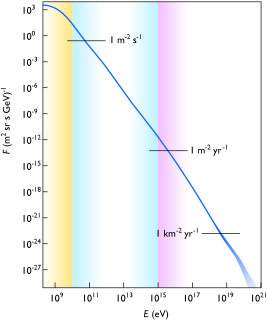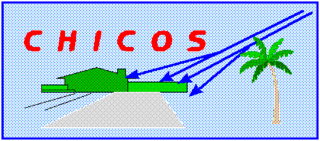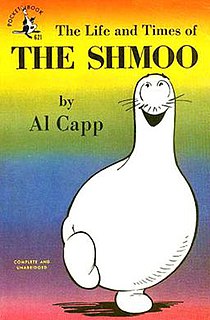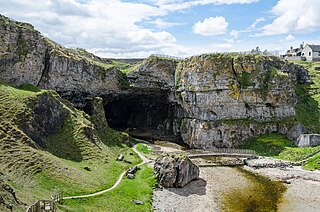
Cosmic rays are a form of high-energy radiation, mainly originating outside the Solar System and even from distant galaxies. Upon impact with the Earth's atmosphere, cosmic rays can produce showers of secondary particles that sometimes reach the surface. Composed primarily of high-energy protons and atomic nuclei, they are originated either from the sun or from outside of our solar system. Data from the Fermi Space Telescope (2013) have been interpreted as evidence that a significant fraction of primary cosmic rays originate from the supernova explosions of stars. Active galactic nuclei also appear to produce cosmic rays, based on observations of neutrinos and gamma rays from blazar TXS 0506+056 in 2018.

Li'l Abner is a satirical American comic strip that appeared in many newspapers in the United States, Canada and Europe, featuring a fictional clan of hillbillies in the impoverished mountain village of Dogpatch, USA. Written and drawn by Al Capp (1909–1979), the strip ran for 43 years, from August 13, 1934 through November 13, 1977. It was originally distributed by United Feature Syndicate, and later by the Chicago Tribune New York News Syndicate. Comic strips typically dealt with northern urban experiences before Capp introduced Li'l Abner, the first strip based in the South. The comic strip had 60 million readers in over 900 American newspapers and 100 foreign papers in 28 countries. Author M. Thomas Inge says Capp "had a profound influence on the way the world viewed the American South."

Sea-Monkeys are a hybrid version of brine shrimp—a group of crustaceans that undergo cryptobiosis. Sea Monkeys are scientifically classified as Artemia NYOS, while brine shrimp are classified as Artemia salina. Sea Monkeys are sold in hatching kits as novelty aquarium pets. Developed in the United States in 1957, at this point being just part of the Artemia salina species, by Harold von Braunhut, the product was heavily marketed, especially in comic books, and remains a presence in popular culture.

Bruno Benedetto Rossi was an Italian experimental physicist. He made major contributions to particle physics and the study of cosmic rays. A 1927 graduate of the University of Bologna, he became interested in cosmic rays. To study them, he invented an improved electronic coincidence circuit, and travelled to Eritrea to conduct experiments that showed that cosmic ray intensity from the West was significantly larger than that from the East.

Karyogamy is the final step in the process of fusing together two haploid eukaryotic cells, and refers specifically to the fusion of the two nuclei. Before karyogamy, each haploid cell has one complete copy of the organism's genome. In order for karyogamy to occur, the cell membrane and cytoplasm of each cell must fuse with the other in a process known as plasmogamy. Once within the joined cell membrane, the nuclei are referred to as pronuclei. Once the cell membranes, cytoplasm, and pronuclei fuse together, the resulting single cell is diploid, containing two copies of the genome. This diploid cell, called a zygote or zygospore can then enter meiosis, or continue to divide by mitosis. Mammalian fertilization uses a comparable process to combine haploid sperm and egg cells (gametes) to create a diploid fertilized egg.
The Oh-My-God particle was the highest-energy cosmic ray detected so far (as of 2019), by the Fly's Eye detector in Dugway Proving Ground, Utah, US, on 15 October 1991. Its energy was estimated as (3.2±0.9)×1020 eV, or 51 J. This is 20 million times more energetic than the highest energy measured in electromagnetic radiation emitted by an extragalactic object and 1020 (100 quintillion) times the photon energy of visible light, equivalent to a 142-gram (5 oz) baseball travelling at about 26 m/s (94 km/h; 58 mph).

Sulphur Mountain is a mountain in Banff National Park in the Canadian Rocky Mountains overlooking the town of Banff, Alberta, Canada.
ShmooCon is an American hacker convention organized by The Shmoo Group. There are typically 40 different talks and presentations on a variety of subjects related to computer security and cyberculture. Multiple events are held at the convention related to cryptography and computer security such as Shmooganography, Hack Fortress, a locksport village hosted by TOOOL DC, and Ghost in the Shellcode. ShmooCon XVI is scheduled to be held January 31 through February 2, 2020.
Super President is an American animated cartoon that aired Saturday mornings on NBC from September 16, 1967 to December 28, 1968. The series was produced by the DePatie-Freleng animation company.
The Cosmic Ray Deflection Society is a satirical/environmental pseudoscientific organization, based in New Orleans, Louisiana. A worldwide membership of over 250 members, the group believes the "deadly cosmic rays" are getting in through the hole in the ozone layer.
The Breakthrough of the Year is an annual award made by the AAAS journal, Science, for the most significant development in scientific research. Originating in 1989 as the Molecule of the Year, and inspired by Time's Man of the Year, it was renamed the Breakthrough of the Year in 1996. The Breakthrough of the Year is widely recognized as one of the highest distinctions in science.
The New Shmoo is a 30-minute Saturday morning animated series based on the character from the Li'l Abner comic strip created by Al Capp, produced by Hanna-Barbera Productions and broadcast on NBC from September 22, 1979 to November 15, 1980.

The California High School Cosmic Ray Observatory,, operated by the Kellogg Laboratory at the California Institute of Technology in Pasadena, California, United States, is one of the world's largest ongoing Cosmic Ray observatory programs. It is known for its large network within the Los Angeles County area, based mainly on high school sites carrying cosmic ray detector units, though there are also detector units on associated elementary schools and middle schools.

Fus3 is a MAPK protein involved in the mating decision of yeast. The dissociation of Fus3 from scaffold protein Ste5 results in the switch-like mating decision observed in yeast. During this process, Fus3 competes with a phosphatase Pte1, attempting to phosphorylate 4 key phosphorylation sites on Ste5. When all 4 sites on Ste5 have been dephosphorylated by Pte1, Fus3 dissociates from Ste5 and trans locates to the nucleus.

BioSentinel is a planned low-cost CubeSat spacecraft on an space biology mission that will use budding yeast to detect, measure, and compare the impact of deep space radiation on DNA repair over long time beyond low-Earth orbit.

Lego DC Comics Super Heroes: Justice League – Cosmic Clash is an animated action comedy film based on the Lego and DC Comics brands, which was released on February 9, 2016 on Digital HD and March 1, 2016 on Blu-ray and DVD. It is the fifth LEGO DC Comics film following Lego Batman: The Movie – DC Super Heroes Unite, Lego DC Comics: Batman Be-Leaguered, Lego DC Comics Super Heroes: Justice League vs. Bizarro League and Lego DC Comics Super Heroes: Justice League: Attack of the Legion of Doom. Some actors from various DC properties reprised their respective roles, including Nolan North as Superman and Khary Payton as Cyborg.
Transient High-Energy Sky and Early Universe Surveyor (THESEUS) is a space telescope mission proposal by the European Space Agency that would study gamma-ray bursts and X-rays for investigating the early universe. If developed, the mission would investigate star formation rates and metallicity evolution, as well as studying the sources and physics of reionization.













